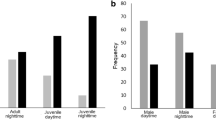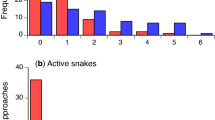Abstract
A total of 21 new taxa of New World pit vipers (Serpentes: Crotalinae) responded by elevating the middle portion of the body in a defensive posture (body bridge) when exposed to the skin substances of certain colubrid snakes (Colubridae). Newborn snakes from two of the three species tested gave the response. Several new species of colubrid snakes also are documented as capable of eliciting a response, and it is suggested that the termophiophage defensive response be used to denote body bridging and associated defensive behaviors instead of the restrictive “kingsnake defense posture.” Most of the snakes which elicit the response in crotaline snakes are known to feed on lizards and/or snakes. There is no apparent correlation between the stimulus snakes' ability to elicit a response in the crotaline snakes and sympatry with the crotaline snakes.
Similar content being viewed by others
References
Aldrich, T.B. 1896. A chemical study of the secretion of the anal glands ofMephitis mephitica (common skunk), with remarks on the physiological properties of the secretion.J. Exp. Med. 1:323–340.
Andersen, K.K., andBernstein, D.T. 1975. Some chemical constituents of the scent of the striped skunk (Mephitis mephitis).J. Chem. Ecol. 1:493–499.
Ansell, A.D. 1969. Escape responses of three Indian molluscs.Veliger 12:157–159.
Bogert, C.M. 1941. Sensory cues used by rattlesnakes in their recognition of ophidian enemies.Ann. N.Y. Acad. Sci. 41:329–343.
Burghardt, G.M. 1970. Chemical perception in reptiles, pp. 241–308,in J.W. Johnston, Jr., D.G. Moulton, and A. Turk (eds.):Communication by Chemical Signals. Appleton-Century-Crofts, New York.
Bustard, H. R. 1969. Defensive display behavior in the bandy-bandy,Vermicella annulata (Serpentes: Elapidae).Herpetologica 25:319–320.
Carpenter, C.C., andGillingham, J.C. 1975. Postural responses to kingsnakes by crotaline snakes.Herpetologica 31:293–302.
Chiszar, D., Scudder, K., Knight, L.,andSmith, H.M. 1978. Exploratory behavior in prairie rattlesnakes (Crotalus viridis) and water moccasins (Agkistrodon piscivorus).Psychol. Rec. 28:363–368.
Clark, W.C. 1958. Escape responses of herbivorous gastropods when stimulated by carnivorous gastropods.Nature 181:137–138.
Conant, R. 1975.A Field Guide to Reptiles and Amphibians of Eastern and Central North America. Houghton Mifflin Co., Boston.
Cowles, R.B. 1938. Unusual defense posture assumed by rattlesnakes.Copeia 1938:13–16.
Cowles, R.B., andPhelan, R.L. 1958. Olfaction in rattlesnakes.Copeia 1958:77–83.
Fitch, H.S. 1960. Autecology of the copperhead.Univ. Kansas Publ. Mus. Nat. Hist. 13:85–288.
Gehlbach, F.R., andBaker, J.K. 1962. Kingsnakes allied withLampropeltismexicana:Taxonomy and natural history.Copeia 1962:291–300.
Greene, H.W. 1977. Phytogeny, convergence, and snake behavior. Unpubl. PhD dissertation, University of Tennessee.
Inger, R.F. Some reactions of rattlesnakes (generaCrotalus and Sistrurus)to kingsnakes (genusLampropeltis). Unpubl. manuscript.
Johnson, C.R. 1970. Defensive displays in some AustralianDenisonia (Serpentes: Elapidae).Herpetologica 26:516–520.
Klauber, L.M. 1927. Some observations on rattlesnakes of the extreme Southwest.Bull. Antivenin Inst. Am. 1:7–21.
Klauber, L.M. 1956.Rattlesnakes, Their Habits, Life Histories and Influence on Mankind, Vol. 2. University of California Press, Berkeley.
Mauzey, K.P., Birkland, C., andDayton, P.K. 1968. Feeding behavior of asteroids and escape responses of their prey in the Puget Sound region.Ecology 49:603–619.
Meade, G.P. 1940. Observations on Louisiana captive snakes.Copeia 1940:165–167.
Mole, R.R. 1924. The Trinidad snakes.Proc. Zool. Soc. London 1924:235–278.
Muller-Schwarze, D. 1972. Responses of young black-tailed deer to predator odors.J. Mammal. 53:393–394.
Neill, W.T. 1947. Size and habits of the cottonmouth moccasin.Herpetologica 3:203–205.
Reed, J.R. 1969. Alarm substances and fright reaction in some fishes from the southeastern United States.Trans. Am. Fish. Soc. 98:664–668.
Snyder, N.F.R. andSnyder, H.A. 1971. Defenses of the Florida apple snailPomaceapaludosa.Behavior 40:175–215.
Ward, J. A. 1965. An investigation of the swimming reaction of the anemoneStomphiacoccinea. I. Partial isolation of a reacting substance from the asteroidDermasterias imbricata.J. Exp. Zool. 159:357–364.
Wright, A. H., andWright, A.A. 1957.Handbook of Snakes of the United States and Canada, Vol. 1. Comstock Publishing Associates, Ithaca, New York.
Yarnall, J.L. 1964. The responses ofTegula funebralis to starfishes and predatory snails (Mollusca: Gastropoda).Veliger (Suppl.) 6:56–58.
Zweifel, R.G., andMorris, K.S. 1955. Contributions to the herpetology of Sonora, Mexico: Descriptions of a new subspecies of snakes (Micruroides euxanthus andLampropeltis gelulus) and miscellaneous collecting notes.Am. Midl. Nat. 54:230–249.
Author information
Authors and Affiliations
Rights and permissions
About this article
Cite this article
Weldon, P.J., Burghardt, G.M. The ophiophage defensive response in crotaline snakes: Extension to new taxa. J Chem Ecol 5, 141–151 (1979). https://doi.org/10.1007/BF00987695
Received:
Revised:
Issue Date:
DOI: https://doi.org/10.1007/BF00987695




